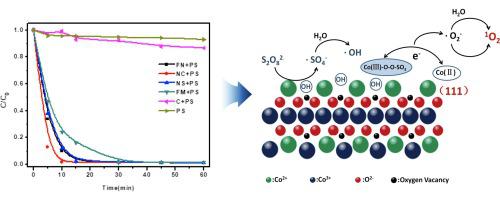当前位置:
X-MOL 学术
›
Appl. Surf. Sci.
›
论文详情
Our official English website, www.x-mol.net, welcomes your
feedback! (Note: you will need to create a separate account there.)
Structure-dependent catalysis of Co3O4 crystals in persulfate activation via nonradical pathway
Applied Surface Science ( IF 6.3 ) Pub Date : 2020-09-01 , DOI: 10.1016/j.apsusc.2020.146482 Weichun Yang , Xingyao Li , Zhi Jiang , Chaofang Li , Jie Zhao , Haiying Wang , Qi Liao
Applied Surface Science ( IF 6.3 ) Pub Date : 2020-09-01 , DOI: 10.1016/j.apsusc.2020.146482 Weichun Yang , Xingyao Li , Zhi Jiang , Chaofang Li , Jie Zhao , Haiying Wang , Qi Liao

|
Abstract Co3O4 crystals with different shapes and surface structures were successfully synthesized. The shapes obtained included flower-like nanoplates (FN), nanocubes (NC), nanosheets (NS) and flake-stacked microsphere (FM). The shapes and surface structures of the Co3O4 catalysts significantly affected their catalytic activity. Among the as-synthesized Co3O4 catalysts, the NC sample displayed the highest catalytic activity in persulfate (PS) activation, achieving almost complete removal of 30 mg L−1 orange G (OG) within 10 min at the reaction conditions of 0.5 g L−1 catalyst and 8.0 mM PS. The excellent catalytic performance of NC sample could be ascribed to dominant exposed crystal plane and abundant surface hydroxyl groups. The electron paramagnetic resonance (EPR) and radical quenching tests demonstrated that reactive oxygen species (ROS) including sulfate radical (·SO4−), hydroxyl radical (·OH), superoxide radical (·O2–) and singlet oxygen (1O2) were generated in the NC/PS system, while 1O2 was dominantly attributed to the OG degradation. The exposed plane of (1 1 1) may be responsible for the generation of 1O2. The study dedicates a novel mechanism of PS heterogeneous activation by Co3O4 crystals and provides an ideal catalyst for efficient removal of organic pollutants in wastewater.
中文翻译:

Co3O4 晶体通过非自由基途径在过硫酸盐活化中的结构依赖性催化
摘要 成功合成了不同形状和表面结构的Co3O4晶体。获得的形状包括花状纳米片(FN)、纳米立方体(NC)、纳米片(NS)和片状堆积微球(FM)。Co3O4 催化剂的形状和表面结构显着影响其催化活性。在合成的 Co3O4 催化剂中,NC 样品在过硫酸盐 (PS) 活化中表现出最高的催化活性,在 0.5 g L− 的反应条件下,在 10 分钟内几乎完全去除了 30 mg L−1 橙色 G (OG) 1 个催化剂和 8.0 mM PS。NC 样品的优异催化性能可归因于显着的暴露晶面和丰富的表面羟基。电子顺磁共振 (EPR) 和自由基猝灭测试表明,产生了活性氧 (ROS),包括硫酸根 (·SO4-)、羟基自由基 (·OH)、超氧自由基 (·O2-) 和单线态氧 (1O2)在 NC/PS 系统中,而 1O2 主要归因于 OG 降解。(1 1 1) 的暴露平面可能是产生 1O2 的原因。该研究致力于通过 Co3O4 晶体对 PS 多相活化的新机制,并为有效去除废水中的有机污染物提供理想的催化剂。
更新日期:2020-09-01
中文翻译:

Co3O4 晶体通过非自由基途径在过硫酸盐活化中的结构依赖性催化
摘要 成功合成了不同形状和表面结构的Co3O4晶体。获得的形状包括花状纳米片(FN)、纳米立方体(NC)、纳米片(NS)和片状堆积微球(FM)。Co3O4 催化剂的形状和表面结构显着影响其催化活性。在合成的 Co3O4 催化剂中,NC 样品在过硫酸盐 (PS) 活化中表现出最高的催化活性,在 0.5 g L− 的反应条件下,在 10 分钟内几乎完全去除了 30 mg L−1 橙色 G (OG) 1 个催化剂和 8.0 mM PS。NC 样品的优异催化性能可归因于显着的暴露晶面和丰富的表面羟基。电子顺磁共振 (EPR) 和自由基猝灭测试表明,产生了活性氧 (ROS),包括硫酸根 (·SO4-)、羟基自由基 (·OH)、超氧自由基 (·O2-) 和单线态氧 (1O2)在 NC/PS 系统中,而 1O2 主要归因于 OG 降解。(1 1 1) 的暴露平面可能是产生 1O2 的原因。该研究致力于通过 Co3O4 晶体对 PS 多相活化的新机制,并为有效去除废水中的有机污染物提供理想的催化剂。

















































 京公网安备 11010802027423号
京公网安备 11010802027423号